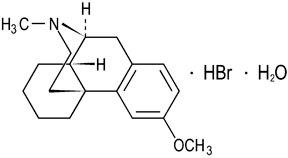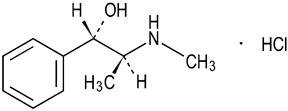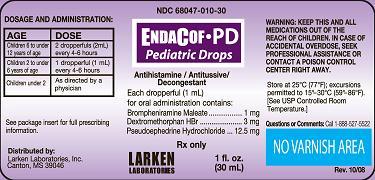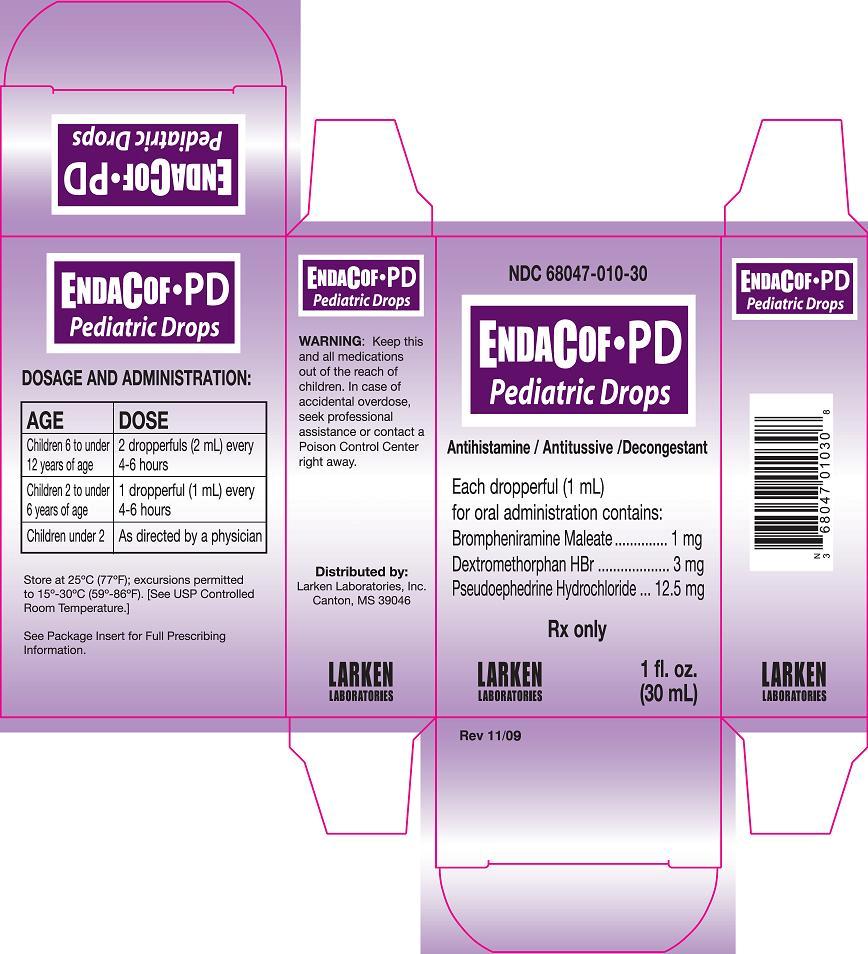ENDACOF PD
-
brompheniramine maleate,
dextromethorphan hydrobromide and
pseudoephedrine hydrochloride solution/ drops
Larken Laboratories, Inc.
Disclaimer: This drug has not been found by FDA to be safe and effective, and this labeling has not been approved by FDA. For further information about unapproved drugs, click here.
----------
DESCRIPTION
EndaCof PD Drops is a sugar free, dye-free antihistamine/ antitussive/decongestant in a clear, grape flavored liquid for oral administration.
Each dropperful (1 mL) contains:
Brompheniramine Maleate, USP . . . . 1 mg
Dextromethorphan HBr, USP . . . . . . . 3 mg
Pseudoephedrine HCl, USP . . . . . . 12.5 mg
INACTIVE INGREDIENT
Inactive Ingredients: Citric acid, flavor, glycerin, sodium benzoate, propylene glycol, purified water, sodium saccharin and sorbitol.
Brompheniramine maleate is a histamine antagonist. Chemically it is 2- Pyridinepropanamine, γ-(4- bromophenyl)-N,N-dimethyl-, (±)-,(Z)-2-butenedioate (1:1) with the following structure:

C16H19BrN2 • C4H4O4 M.W. 435.31
Dextromethorphan Hydrobromide is a cough suppressant with the chemical name: Morphinan,
3-methoxy-17-methyl-, (9α,13α,14α)-, hydrobromide, monohydrate. Its structure is as follows:

C18H25NO • HBr • H2O M.W. 370.33
Pseudoephedrine Hydrochloride is a nasal decongestant with the chemical name Benzenemethanol, α-[1-(methylamino)ethyl]-,[S-(R*,R*)]-, hydrochloride. Its structure is as follows:

C10H15NO • HCl M.W. 201.69
CLINICAL PHARMACOLOGY
Brompheniramine Maleate is a histamine antagonist, specifically an H1-receptor-blocking agent belonging to the alkylamine class of antihistamines. Antihistamines appear to compete with histamine for receptor sites on effector cells. Brompheniramine also has anticholinergic (drying) and sedative effects. Among the antihistaminic effects, it antagonizes the allergic response (vasodilatation, increased vascular permeability, increased mucus secretion) of nasal tissue. Brompheniramine is well absorbed from the gastrointestinal tract, with peak plasma concentration after single, oral dose of 4 mg reached in 5 hours; urinary excretion is the major route of elimination, mostly as products of biodegradation; the liver is assumed to be the main site of metabolic transformation.
Dextromethorphan Hydrobromide acts centrally to elevate the threshold for coughing. It has no analgesic or addictive properties. The onset of antitussive action occurs in 15 to 30 minutes after administration and is of long duration.
Pseudoephedrine Hydrochloride acts on sympathetic nerve endings and also on smooth muscle, making it useful as a nasal decongestant. The nasal decongestant effect is mediated by the action of pseudoephedrine on α-sympathetic receptors, producing vasoconstriction of the dilated nasal arterioles. Following oral administration, effects are noted within 30 minutes with peak activity occurring at approximately one hour.
INDICATIONS AND USAGE
Temporarily relieves nasal congestion and pressure, runny nose, sneezing, itching of the nose or throat, itchy watery eyes, and cough due to minor throat and bronchial irritation associated with a cold, hay fever, or other upper respiratory allergies (allergic rhinitis).
CONTRAINDICATIONS
EndaCof PD is contraindicated in patients with hypersensitivity or idiosyncrasy to any of its ingredients. Sympathomimetic amines are contraindicated in patients with severe hypertension, severe coronary artery disease and patients on monoamine oxidase (MAO) Inhibitor therapy. Antihistamines are contraindicated in patients with narrow angle glaucoma, urinary retention, peptic ulcer, and during an asthma attack.
Dextromethorphan should not be used in patients receiving a monoamine oxidase inhibitor (MAOI) or for 2 weeks after stopping the MAOI drug.
WARNINGS
Do not exceed recommended dosage. Sympathomimetic amines should be used judiciously and sparingly in patients with hypertension, diabetes, ischemic heart disease, hyperthyroidism, increased intraocular pressure or prostatic hypertrophy. (See Contraindications section.) Sympathomimetic amines may produce CNS stimulation with convulsions or cardiovascular collapse with accompanying hypotension. The elderly (60 years and older) are more likely to exhibit adverse reactions. Antihistamines may cause excitability, especially in children. At doses higher than the recommended dose, nervousness, dizziness, or sleeplessness may occur. Administration of dextromethorphan may be accompanied by histamine release and should be used with caution in atopic children.
PRECAUTIONS
General
General: Before prescribing medication to suppress or modify cough, identify and provide therapy for the underlying cause of cough and take caution that modification of cough does not increase the risk of clinical or physiologic complications. Dextromethorphan should be used with caution in sedated or debilitated patients and in patients confined to supine positions. Use with caution in patients with hypertension, heart disease, asthma, hyperthyroidism, increased intraocular pressure, diabetes mellitus and prostatic hypertrophy.
Information for Patients
Information for Patients: Avoid alcohol and other CNS depressants while taking these products. Patients sensitive to antihistamines may experience moderate to severe drowsiness. Patients sensitive to sympathomimetic amines may notice mild CNS stimulation. Antihistamines may impair mental and physical abilities required for the performance of potentially hazardous tasks such as driving a vehicle or operating machinery. Patients should be warned accordingly.
Drug Interactions
Drug Interactions: Antihistamines may enhance the effects of tricyclic antidepressants, barbiturates, alcohol, and other CNS depressants. MAO inhibitors prolong and intensify the anticholinergic effects of antihistamines. Sympathomimetic amines may reduce the antihypertensive effects of reserpine, veratrum alkaloids, methyldopa and mecamylamine. Effects of sympathomimetics are increased with MAO inhibitors and beta-adrenergic blockers. The cough-suppressant action of dextromethorphan and narcotic antitussives are additive. Dextromethorphan is contraindicated with monoamine oxidase inhibitors (MAOI), (See Contraindications section.)
Pregnancy
Use in Pregnancy: Pregnancy Category C. Animal reproduction studies have not been conducted with this product. It is not known whether this product can cause fetal harm when administered to a pregnant woman or affect reproduction capacity. Give to pregnant women only if clearly needed.
Nursing Mothers
Nursing Mothers: It is not known whether the drugs in this product are excreted in human milk. Since many drugs are excreted in human milk and because of the potential for serious adverse reactions in nursing infants, a decision should be made whether to discontinue nursing or discontinue the use of this product, taking into account the importance of the drug to the mother.
Special Risk Patients: Use with caution in patients with hypertension or ischemic heart disease and persons older than 60 years of age.
ADVERSE REACTIONS
Antihistamines may cause sedation, dizziness, diplopia, vomiting, diarrhea, dry mouth, headache, nervousness, nausea, anorexia, heartburn, weakness, polyuria and dysuria and, rarely, excitability in children. Urinary retention may occur in patients with prostatic hypertrophy.
Dextromethorphan may cause drowsiness, dizziness, and GI disturbance.
Sympathomimetic Amines: Convulsions, CNS stimulation, cardiac arrhythmias, respiratory difficulties, increased heart rate or blood pressure, hallucinations, tremors, nervousness, insomnia, weakness, pallor and dysuria.
OVERDOSAGE
No information is available as to specific results of an overdose of this product. The signs, symptoms and treatment described below are those of H1 antihistamine, ephedrine and dextromethorphan overdose.
Symptoms: Should antihistamine effects predominate, central action constitutes the greatest danger. In the small child, predominant symptoms are excitation, hallucination, ataxia, incoordination, tremors, flushed face and fever. Convulsions, fixed and dilated pupils, coma and death may occur in severe cases. In the adult, fever and flushing are uncommon; excitement leading to convulsions and postictal depression is often preceded by drowsiness and coma. Respiration is usually not seriously depressed; blood pressure is usually stable.
Should sympathomimetic symptoms predominate, central effects include restlessness, dizziness, tremor, hyperactive reflexes, talkativeness, irritability and insomnia. Cardiovascular and renal effects include difficulty in micturition, headache, flushing, palpitation, cardiac arrhythmias, hypertension with subsequent hypotension and circulatory collapse. Gastrointestinal effects include dry mouth, metallic taste, anorexia, nausea, vomiting, diarrhea, and abdominal cramps.
Dextromethorphan may cause respiratory depression with a large overdose.
Treatment: The stomach should be emptied promptly by emetics and/or gastric lavage. The installation of activated charcoal also should be considered. Cardiac function and serum electrolytes should be monitored and treatment initiated if indicated. If convulsions or marked CNS excitement occurs, diazepam may be used.
DOSAGE AND ADMINISTRATION
| AGE | DOSE |
| Children 6 to under 12 years of age | 2 dropperfuls (2 mL) every 4-6 hours |
| Children 2 to under 6 years of age | 1 dropperful (1 mL) every 4-6 hours |
| Children under 2 | As directed by a physician |
HOW SUPPLIED
EndaCof PD Drops is supplied in bottles of 1 fl. oz. (30 mL), NDC 68047-010-30. Calibrated, shatter-proof dropper enclosed in each carton.
Storage and Handling
Store at 25°C (77°F); excursions permitted to 15°- 30°C (59°- 86°F). [See USP Controlled Room Temperature.]
EndaCof PD contains safety seal under bottle cap. Pharmacist, dispense in original container.
KEEP THIS AND ALL MEDICATIONS OUT OF THE REACH OF CHILDREN. IN CASE OF ACCIDENTAL OVERDOSE, SEEK PROFESSIONAL ASSISTANCE OR CONTACT A POISON CONTROL CENTER IMMEDIATELY.
Distributed by:
LARKEN LABORATORIES, INC
Canton, MS 39046
Rev. 10/08
| ENDACOF
PD
brompheniramine maleate / dextromethorphan hbr / pseudoephedrine hcl solution/ drops |
||||||||||||||||||||
|
||||||||||||||||||||
|
||||||||||||||||||||
|
||||||||||||||||||||
|
||||||||||||||||||||
|
||||||||||||||||||||
| Marketing Information | |||
| Marketing Category | Application Number or Monograph Citation | Marketing Start Date | Marketing End Date |
| Unapproved drug other | 07/05/2004 | 11/30/2011 | |
| Labeler - Larken Laboratories, Inc. (791043719) |
| Registrant - Larken Laboratories, Inc. (791043719) |
Revised: 04/2012 Larken Laboratories, Inc.

